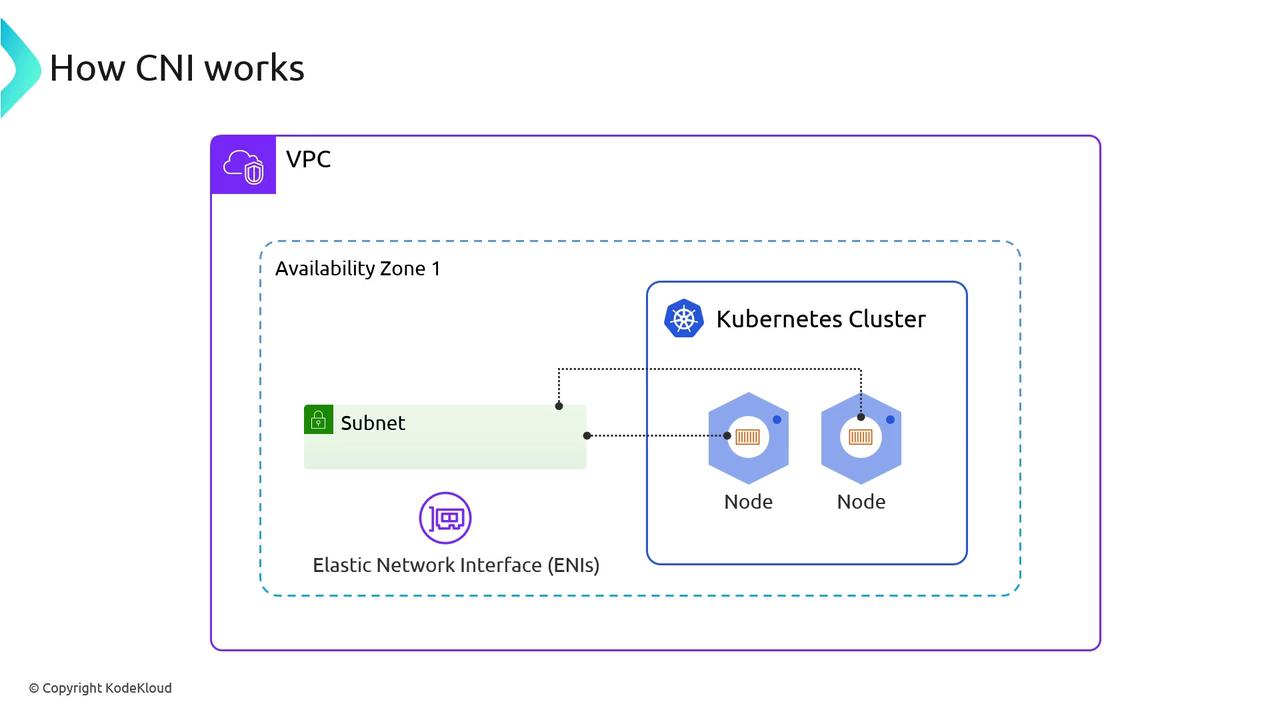AWS EKS
EKS Networking
How networking works
In this guide, we’ll walk through how the AWS VPC CNI plugin assigns IPs to your EKS cluster’s nodes and pods. Each node and pod runs on Elastic Network Interfaces (ENIs) within the VPC subnets in their Availability Zone. Understanding this CNI integration helps you optimize pod density, avoid IP exhaustion, and fine-tune scaling parameters.

1. Confirm Your EKS Cluster
Start by verifying which EKS cluster is active:
eksdemo get clusters
+-----------+--------+-----------+---------+----------+
| Age | Status | Cluster | Version | Platform |
+-----------+--------+-----------+---------+----------+
| 45 minutes| ACTIVE | *kodekloud| 1.28 | eks.7 | Public |
+-----------+--------+-----------+---------+----------+
* Indicates current context in local kubeconfig
2. Inspect VPCs and Subnets
It’s recommended to dedicate one VPC per EKS cluster to simplify IP management:
eksdemo get vpc
eksdemo get subnets
A /16 VPC block yields ~65,000 IPv4 addresses—enough for control plane, nodes, pods, and endpoints.
Warning
Running multiple clusters in a single VPC can lead to IP exhaustion. Always project your pod and node scale before choosing CIDR sizes.
3. List ENIs in the VPC
AWS attaches ENIs for both control-plane interfaces and worker-node networking. Use this table to distinguish primary vs. secondary ENIs:
| ENI Type | Description | Attached To | IPs per ENI |
|---|---|---|---|
| Primary ENI | eth0, node’s main interface | EC2 instances (nodes) | 1 |
| Secondary ENI | eth1, eth2… for pod traffic | EC2 instances (nodes) | Up to 12 |
| Control-Plane | Managed by AWS for the EKS API endpoints | eks_control_plane | 1 |
eksdemo get network-interfaces
4. Kubernetes Data Plane: Nodes & Pods
Verify that your nodes are Ready and system pods are running:
kubectl get nodes
kubectl get pods -A -o wide
By default, EKS runs:
- aws-node DaemonSet (VPC CNI plugin)
- kube-proxy
- coredns for DNS resolution
5. Examine the aws-node DaemonSet
Describe the DaemonSet to view replicas and container images:
kubectl describe ds aws-node -n kube-system
Key fields:
- Desired / Current / Ready pod counts
- Init Container:
aws-vpc-cni-init - Main Container:
aws-node(configures ENIs, warm IP pools) - Sidecar:
aws-eks-nodeagent(eBPF network policies)
6. aws-node Pod Spec Breakdown
Below is a trimmed excerpt of the DaemonSet pod spec:
initContainers:
- name: aws-vpc-cni-init
image: amazon-k8s-cni-init:v1.6.3
env:
- name: ENABLE_IPv6
value: "false"
volumeMounts:
- name: cni-bin-dir
mountPath: /host/opt/cni/bin
containers:
- name: aws-node
image: amazon-k8s-cni:v1.16.2-eksbuild.1
env:
- name: WARM_ENI_TARGET
value: "1"
- name: WARM_PREFIX_TARGET
value: "1"
- name: VPC_ID
value: "vpc-068d84bd223c3afd6"
volumeMounts:
- name: cni-net-dir
mountPath: /host/etc/cni/net.d
- name: run-dir
mountPath: /var/run/aws-node
- name: aws-eks-nodeagent
image: aws-network-policy-agent:v1.0.7-eksbuild.1
args:
- --enable-network-policy=true
- --enable-ipv6=false
volumeMounts:
- name: bpf-pin-path
mountPath: /sys/fs/bpf
Note
Adjust environment variables like WARM_ENI_TARGET and WARM_PREFIX_TARGET to control how many spare IPs the plugin keeps ready.
7. View Init Container Logs
The init container seeds CNI binaries and tunes sysctls:
kubectl logs -n kube-system aws-node-xxxxx -c aws-vpc-cni-init
Sample output:
Copying CNI plugin binaries ...
Updated net/ipv4/conf/eth0/rp_filter to 2
CNI init container done
8. Inspect Node Network Interfaces
SSH into any worker node to see eth0 (primary) and secondary ENIs:
ip a
Typical output:
2: eth0: inet 192.168.132.239/19 ...
3: eniXXXX@if3: inet 192.168.141.232/19 ...
- eth0: Node’s primary IP
- eni…: Pod IPs handled by the CNI
9. Review Host CNI Configuration
The init container writes /etc/cni/net.d/10-aws.conflist on each node:
cat /etc/cni/net.d/10-aws.conflist
Key sections:
"type": "aws-cni"plugin"vethPrefix": "eni""mtu": "9001"- Egress CNI stub
10. List CNI Plugin Binaries
CNI executables live under /opt/cni/bin on each node:
ls -1 /opt/cni/bin
Examples include:
- aws-cni
- egress-cni
- bridge, dhcp, host-local, bandwidth, firewall
11. Verify the aws-cni Binary
Confirm supported CNI versions using the help flag:
/opt/cni/bin/aws-cni --help
Output shows supported protocols:
CNI protocol versions supported: 0.1.0, 0.2.0, 0.3.0, 0.3.1, 0.4.0, 1.0.0
Further Reading
Watch Video
Watch video content